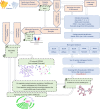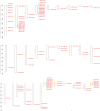Whole genome discovery of regulatory genes responsible for the response of chicken to heat stress
- PMID: 38503864
- PMCID: PMC10951342
- DOI: 10.1038/s41598-024-56757-0
Whole genome discovery of regulatory genes responsible for the response of chicken to heat stress
Abstract
Long noncoding RNAs (lncRNAs) are functional bridges connecting the genome with phenotypes by interacting with DNA, mRNA, and proteins. Using publically available acute heat stress (AHS)-related RNA-seq data, we discovered novel lncRNAs and tested their association with AHS along with ~ 8800 known lncRNAs and ~ 28,000 mRNA transcripts. Our pipeline discovered a total of 145 potentially novel-lncRNAs. One of them (Fishcomb_p-value = 0.06) along with another novel transcript (annotated as protein-coding; Fishcomb_p-value = 0.03) were identified as significantly associated with AHS. We found five known-lncRNAs and 134 mRNAs transcripts that were significantly associated with AHS. Four novel lncRNAs interact cis-regulated with 12 mRNA transcripts and are targeted by 11 miRNAs. Also six meta-lncRNAs associate with 134 meta-mRNAs through trans-acting co-expression, each targeted by 15 and 216 miRNAs, respectively. Three of the known-lncRNAs significantly co-expressed with almost 97 of the significant mRNAs (Pearson correlation p-value < 0.05). We report the mentioned three known-lncRNAs (ENSGALT00000099876, ENSGALT00000107573, and ENSGALT00000106323) as the most, significantly regulatory elements of AHS in chicken. It can be concluded that in order to alleviate the adverse effects of AHS on chicken, the manipulation of the three regulatory lncRNAs could lead to a more desirable result than the manipulation of the most significant mRNAs.
Keywords: Acute heat stress; Long-noncoding-RNAs; Meta-analysis; RNA-seq.
© 2024. The Author(s).
Conflict of interest statement
The authors declare no competing interests.
Figures











Similar articles
-
Third-generation sequencing found LncRNA associated with heat shock protein response to heat stress in Populus qiongdaoensis seedlings.BMC Genomics. 2020 Aug 24;21(1):572. doi: 10.1186/s12864-020-06979-z. BMC Genomics. 2020. PMID: 32831021 Free PMC article.
-
Integrated analysis of long non-coding RNAs and mRNAs reveals the regulatory network of maize seedling root responding to salt stress.BMC Genomics. 2022 Jan 13;23(1):50. doi: 10.1186/s12864-021-08286-7. BMC Genomics. 2022. PMID: 35026983 Free PMC article.
-
Systematic identification and analysis of heat-stress-responsive lncRNAs, circRNAs and miRNAs with associated co-expression and ceRNA networks in cucumber (Cucumis sativus L.).Physiol Plant. 2020 Mar;168(3):736-754. doi: 10.1111/ppl.12997. Epub 2019 Jun 25. Physiol Plant. 2020. PMID: 31125116
-
Integrated analysis of noncoding RNAs and mRNAs reveals their potential roles in chicken spleen response to Klebsiella variicola infection.Res Vet Sci. 2023 Nov;164:105029. doi: 10.1016/j.rvsc.2023.105029. Epub 2023 Sep 23. Res Vet Sci. 2023. PMID: 37769515
-
lncRNAs in Stress Response.Curr Top Microbiol Immunol. 2016;394:203-36. doi: 10.1007/82_2015_489. Curr Top Microbiol Immunol. 2016. PMID: 26658944 Free PMC article. Review.
Cited by
-
Genome-wide association study and transcriptomic analysis reveal the crucial role of sting1 in resistance to visceral white-nodules disease in Larimichthys polyactis.Front Immunol. 2025 Apr 28;16:1562307. doi: 10.3389/fimmu.2025.1562307. eCollection 2025. Front Immunol. 2025. PMID: 40356894 Free PMC article.
-
Integrated TWAS, GWAS, and RNAseq results identify candidate genes associated with reproductive traits in cows.Sci Rep. 2025 Jan 14;15(1):1932. doi: 10.1038/s41598-024-82448-x. Sci Rep. 2025. PMID: 39809816 Free PMC article.
References
-
- Etches, R. J., John, T. M. & Gibbins, A. M. V. Behavioural, physiological, neuroendocrine and molecular responses to heat stress. In Poultry Production in Hot Climates. 48–79 (CABI Wallingford, 2008).
-
- Lin, H., Decuypere, E. & Buyse, J. Acute heat stress induces oxidative stress in broiler chickens. Comp. Biochem. Physiol. Part A Mol. Integr. Physiol.144, 11–17 (2006). - PubMed
MeSH terms
Substances
LinkOut - more resources
Full Text Sources

